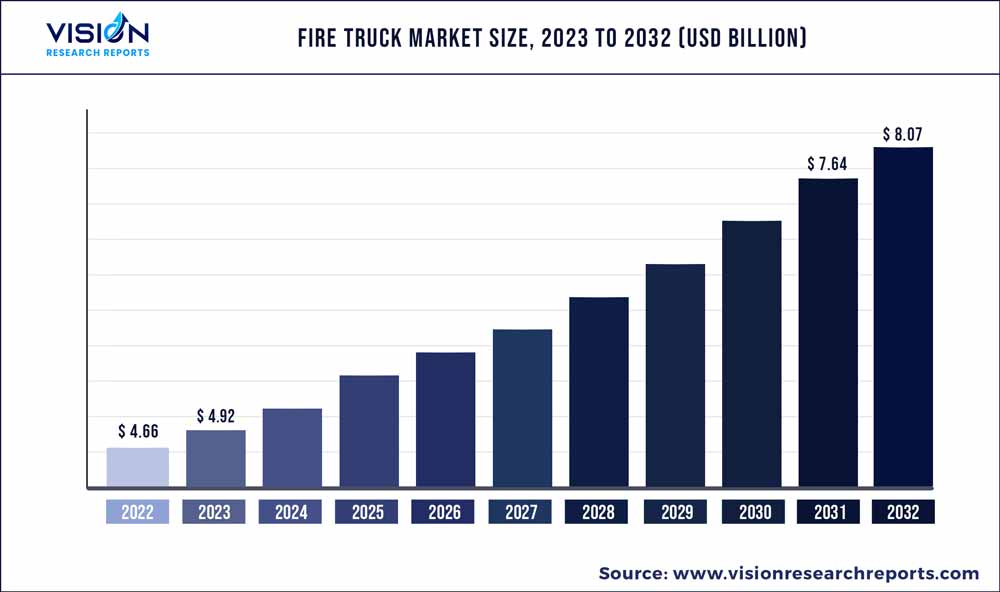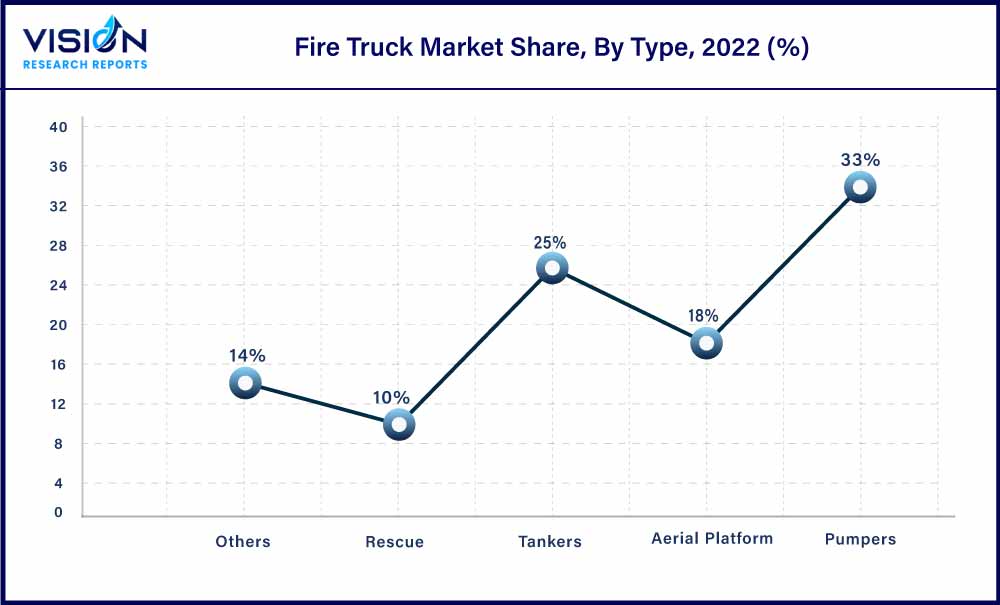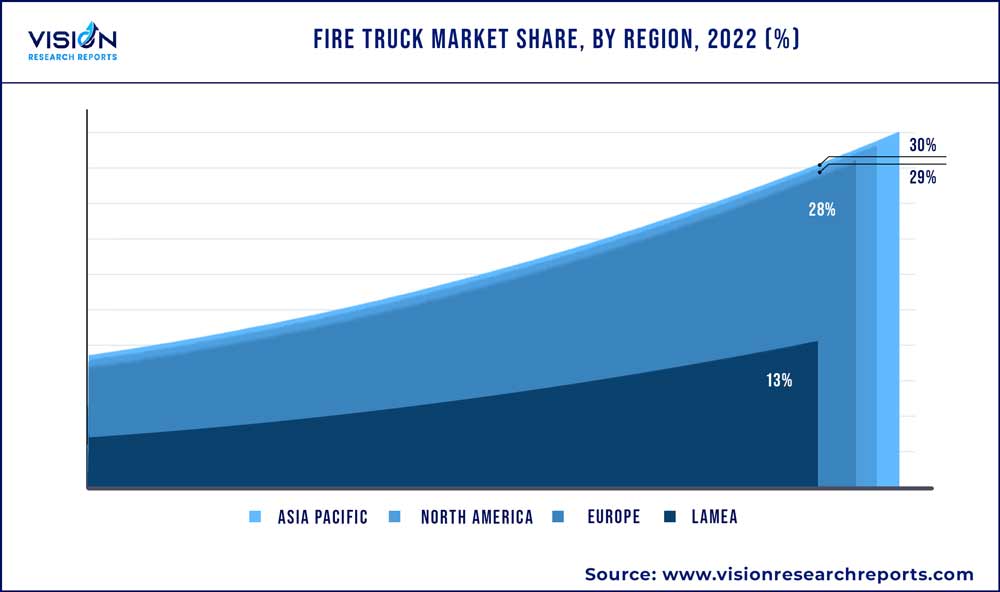The global fire truck market was surpassed at USD 4.66 billion in 2022 and is expected to hit around USD 8.07 billion by 2032, growing at a CAGR of 5.64% from 2023 to 2032. The fire truck market in the United States was accounted for USD 888 million in 2022.

Key Pointers
Report Scope of the Fire Truck Market
| Report Coverage | Details |
| Revenue Share of Asia Pacific in 2022 | 30% |
| Revenue Forecast by 2032 | USD 8.07 billion |
| Growth Rate from 2023 to 2032 | CAGR of 5.64% |
| Base Year | 2022 |
| Forecast Period | 2023 to 2032 |
| Market Analysis (Terms Used) | Value (US$ Million/Billion) or (Volume/Units) |
| Companies Covered | Rosenbauer International AG; Oshkosh Corporation; Magirus GmbH; Weihai Guangtai; Danko Emergency Equipment Co.; E-One Inc.; Spartan Motors; Xuzhou Handler Special Vehicle Co. Ltd.; Zoomlion; Bronto Skylift Oy Ab |
The necessity for advanced firefighting equipment and the rising demand for fire safety in developed nations are anticipated to boost the market expansion forfire trucks. A substantial increase in demand for fire safety among developed countries and the need for advanced firefighting equipment are factors expected to augment the market growth. Furthermore, improving standards concerning safety across the globe are expected to aid the demand for advanced fire trucks in the coming years.
The outbreak of COVID-19 negatively impacted the market globally. Because of the stoppage of transit and international trade, makers of firefighting vehicles had to deal with some supply chain challenges. However, the industry started to pick up steam in the subsequent months, and throughout the projected period, it is anticipated that the demand for firefighting vehicles will increase significantly. The development of electri3c trucks and the rising popularity of firefighting equipment and local assemblies are projected to have a beneficial impact on the market for fire trucks.
The noticeable increase in demand for fire trucks can be attributed to factors such as new infrastructure development and an increase in fire incidents in residential and commercial spaces, as well as sanctuaries and wildlife areas. For instance, in 2021, the U.S. witnessed around 8,619 wildfires that destroyed 2.6 million acres of land as well as close to 3,629 structures, while it also involved extensive loss of human life.
One of the biggest markets for fire trucks is China due to the growing economy and rapid urbanization, combined with strict codes and standards for the decrease in infrastructural damage and loss that have created a need for fire trucks and emergency equipment. As China continues to build its civil aviation airport infrastructure, the need for fire and safety equipment keeps rising. The country built 43 airports between 2016 and 2020 and close to 6 new airports in 2021, bringing the number of airports operating in the country to 247.
Furthermore, the departments need to keep upgrading their equipment and apparatus owing to the constant technological advancements in the sector. As a result, frequent amendments are made to the guidelines and regulations enforced by associations such as the National Fire Protection Association (NFPA) in the U.S. and the National Association of Fire Equipment in India.
Infrastructural development in emerging countries has led regulatory bodies to enforce stringent codes and standards to decrease infrastructural damage and losses, which is expected to augment the industry’s growth. However, high preliminary costs and capital requirements for the manufacturing of trucks are expected to restrain the market growth to a certain extent over the forecast period.
Application Insights
The residential & commercial application segment accounted for the largest share in the global market for fire trucks and is expected to expand at a steady CAGR of 6.03% over the forecast period. The market growth in this segment is anticipated to augment on account of the rising global population, which in turn is expected to increase the demand for the construction of residential and commercial buildings.
The growing population and the resultant spike in building & construction activities worldwide have led to governments enforcing stringent fire safety regulations across several critical sectors, including residential, commercial, airports, and industries. This factor has resulted in a significant increase in the global consumption of fire trucks in residential & commercial applications.
The growing utilization of Aircraft Rescue Fire Fighting (ARFF) vehicles for airport safety and rescue operations is expected to drive the market demand in the enterprises & airports segment. This segment accounted for 25% of the total market share in terms of revenue in 2022. The presence of ARFF is anticipated to increase this segment’s market share, owing to the rapidly growing number of airports and air passenger traffic globally.
The continuously rising demand for advanced firefighting apparatus in developed countries such as the UK, France, and the U.S. is expected to augment the growth of the market in North America and Europe. On the other hand, the steadily increasing building & construction activities, coupled with low prices, are expected to drive market growth in China over the forecast period.
Type Insight
In 2022, the pumper segment accounted for the largest revenue share of 33% of the market. The popularity and product demand of pumper trucks will increase over the projection period due to their ability to pump water from outside sources such as water tankers, wells, and overhead tanks, as well as their lower cost when compared to other high-tech fire truck models. Based on type, the market for fire trucks is bifurcated into tankers, pumpers, aerial platforms, rescue, and others.

Several factors, including population growth, an increase in building and construction activities, and governments implementing stringent fire safety rules, have contributed to an increase in the demand for tankers in recent years. This trend is anticipated to continue further in the years to come.
Regional Insights
The global fire trucks industry is led by the Asia Pacific, with the region accounting for 30% of the revenue share in 2022, and is expected to continue its dominance throughout the forecast period. The presence of key low-cost manufacturers in China, coupled with the rising demand from residential & commercial applications in emerging economies such as China, South Korea, and India, majorly drive the fire truck market growth in the region.

China is one of the largest markets, both in terms of production as well as consumption. The high production capacity and supply are driven by the considerably low costs of production. In addition, the country is an industrial hub for several global manufacturers. Increased utilization of fire trucks is anticipated in applications such as commercial spaces, enterprises, and airports, owing to the aforementioned factors.
The North American market contributed to around 25.14% of the revenue share in 2022. The North American production value witnessed a significant increase that is primarily driven by the increased demand from the residential & commercial application segment. Furthermore, the growing requirement for advanced safety infrastructure in residential buildings, commercial complexes, and enterprises is expected to augment themarket demand for fire trucks.
Fire Truck Market Segmentations:
By Application
By Type
By Regional
Chapter 1. Introduction
1.1. Research Objective
1.2. Scope of the Study
1.3. Definition
Chapter 2. Research Methodology
2.1. Research Approach
2.2. Data Sources
2.3. Assumptions & Limitations
Chapter 3. Executive Summary
3.1. Market Snapshot
Chapter 4. Market Variables and Scope
4.1. Introduction
4.2. Market Classification and Scope
4.3. Industry Value Chain Analysis
4.3.1. Raw Material Procurement Analysis
4.3.2. Sales and Distribution Channel Analysis
4.3.3. Downstream Buyer Analysis
Chapter 5. COVID 19 Impact on Fire Truck Market
5.1. COVID-19 Landscape: Fire Truck Industry Impact
5.2. COVID 19 - Impact Assessment for the Industry
5.3. COVID 19 Impact: Global Major Government Policy
5.4. Market Trends and Opportunities in the COVID-19 Landscape
Chapter 6. Market Dynamics Analysis and Trends
6.1. Market Dynamics
6.1.1. Market Drivers
6.1.2. Market Restraints
6.1.3. Market Opportunities
6.2. Porter’s Five Forces Analysis
6.2.1. Bargaining power of suppliers
6.2.2. Bargaining power of buyers
6.2.3. Threat of substitute
6.2.4. Threat of new entrants
6.2.5. Degree of competition
Chapter 7. Competitive Landscape
7.1.1. Company Market Share/Positioning Analysis
7.1.2. Key Strategies Adopted by Players
7.1.3. Vendor Landscape
7.1.3.1. List of Suppliers
7.1.3.2. List of Buyers
Chapter 8. Global Fire Truck Market, By Application
8.1. Fire Truck Market, by Application, 2023-2032
8.1.1. Residential & Commercial
8.1.1.1. Market Revenue and Forecast (2020-2032)
8.1.2. Enterprises & Airports
8.1.2.1. Market Revenue and Forecast (2020-2032)
8.1.3. Military
8.1.3.1. Market Revenue and Forecast (2020-2032)
8.1.4. Others
8.1.4.1. Market Revenue and Forecast (2020-2032)
Chapter 9. Global Fire Truck Market, By Type
9.1. Fire Truck Market, by Type, 2023-2032
9.1.1. Tankers
9.1.1.1. Market Revenue and Forecast (2020-2032)
9.1.2. Pumpers
9.1.2.1. Market Revenue and Forecast (2020-2032)
9.1.3. Aerial Platform
9.1.3.1. Market Revenue and Forecast (2020-2032)
9.1.4. Rescue
9.1.4.1. Market Revenue and Forecast (2020-2032)
9.1.5. Others
9.1.5.1. Market Revenue and Forecast (2020-2032)
Chapter 10. Global Fire Truck Market, Regional Estimates and Trend Forecast
10.1. North America
10.1.1. Market Revenue and Forecast, by Application (2020-2032)
10.1.2. Market Revenue and Forecast, by Type (2020-2032)
10.1.3. U.S.
10.1.3.1. Market Revenue and Forecast, by Application (2020-2032)
10.1.3.2. Market Revenue and Forecast, by Type (2020-2032)
10.1.4. Rest of North America
10.1.4.1. Market Revenue and Forecast, by Application (2020-2032)
10.1.4.2. Market Revenue and Forecast, by Type (2020-2032)
10.2. Europe
10.2.1. Market Revenue and Forecast, by Application (2020-2032)
10.2.2. Market Revenue and Forecast, by Type (2020-2032)
10.2.3. UK
10.2.3.1. Market Revenue and Forecast, by Application (2020-2032)
10.2.3.2. Market Revenue and Forecast, by Type (2020-2032)
10.2.4. Germany
10.2.4.1. Market Revenue and Forecast, by Application (2020-2032)
10.2.4.2. Market Revenue and Forecast, by Type (2020-2032)
10.2.5. France
10.2.5.1. Market Revenue and Forecast, by Application (2020-2032)
10.2.5.2. Market Revenue and Forecast, by Type (2020-2032)
10.2.6. Rest of Europe
10.2.6.1. Market Revenue and Forecast, by Application (2020-2032)
10.2.6.2. Market Revenue and Forecast, by Type (2020-2032)
10.3. APAC
10.3.1. Market Revenue and Forecast, by Application (2020-2032)
10.3.2. Market Revenue and Forecast, by Type (2020-2032)
10.3.3. India
10.3.3.1. Market Revenue and Forecast, by Application (2020-2032)
10.3.3.2. Market Revenue and Forecast, by Type (2020-2032)
10.3.4. China
10.3.4.1. Market Revenue and Forecast, by Application (2020-2032)
10.3.4.2. Market Revenue and Forecast, by Type (2020-2032)
10.3.5. Japan
10.3.5.1. Market Revenue and Forecast, by Application (2020-2032)
10.3.5.2. Market Revenue and Forecast, by Type (2020-2032)
10.3.6. Rest of APAC
10.3.6.1. Market Revenue and Forecast, by Application (2020-2032)
10.3.6.2. Market Revenue and Forecast, by Type (2020-2032)
10.4. MEA
10.4.1. Market Revenue and Forecast, by Application (2020-2032)
10.4.2. Market Revenue and Forecast, by Type (2020-2032)
10.4.3. GCC
10.4.3.1. Market Revenue and Forecast, by Application (2020-2032)
10.4.3.2. Market Revenue and Forecast, by Type (2020-2032)
10.4.4. North Africa
10.4.4.1. Market Revenue and Forecast, by Application (2020-2032)
10.4.4.2. Market Revenue and Forecast, by Type (2020-2032)
10.4.5. South Africa
10.4.5.1. Market Revenue and Forecast, by Application (2020-2032)
10.4.5.2. Market Revenue and Forecast, by Type (2020-2032)
10.4.6. Rest of MEA
10.4.6.1. Market Revenue and Forecast, by Application (2020-2032)
10.4.6.2. Market Revenue and Forecast, by Type (2020-2032)
10.5. Latin America
10.5.1. Market Revenue and Forecast, by Application (2020-2032)
10.5.2. Market Revenue and Forecast, by Type (2020-2032)
10.5.3. Brazil
10.5.3.1. Market Revenue and Forecast, by Application (2020-2032)
10.5.3.2. Market Revenue and Forecast, by Type (2020-2032)
10.5.4. Rest of LATAM
10.5.4.1. Market Revenue and Forecast, by Application (2020-2032)
10.5.4.2. Market Revenue and Forecast, by Type (2020-2032)
Chapter 11. Company Profiles
11.1. Rosenbauer International AG
11.1.1. Company Overview
11.1.2. Product Offerings
11.1.3. Financial Performance
11.1.4. Recent Initiatives
11.2. Oshkosh Corporation
11.2.1. Company Overview
11.2.2. Product Offerings
11.2.3. Financial Performance
11.2.4. Recent Initiatives
11.3. Magirus GmbH
11.3.1. Company Overview
11.3.2. Product Offerings
11.3.3. Financial Performance
11.3.4. Recent Initiatives
11.4. Weihai Guangtai
11.4.1. Company Overview
11.4.2. Product Offerings
11.4.3. Financial Performance
11.4.4. LTE Scientific
11.5. Danko Emergency Equipment Co.
11.5.1. Company Overview
11.5.2. Product Offerings
11.5.3. Financial Performance
11.5.4. Recent Initiatives
11.6. E-One Inc.
11.6.1. Company Overview
11.6.2. Product Offerings
11.6.3. Financial Performance
11.6.4. Recent Initiatives
11.7. Spartan Motors
11.7.1. Company Overview
11.7.2. Product Offerings
11.7.3. Financial Performance
11.7.4. Recent Initiatives
11.8. Xuzhou Handler Special Vehicle Co. Ltd.
11.8.1. Company Overview
11.8.2. Product Offerings
11.8.3. Financial Performance
11.8.4. Recent Initiatives
11.9. Zoomlion
11.9.1. Company Overview
11.9.2. Product Offerings
11.9.3. Financial Performance
11.9.4. Recent Initiatives
11.10. Bronto Skylift Oy Ab
11.10.1. Company Overview
11.10.2. Product Offerings
11.10.3. Financial Performance
11.10.4. Recent Initiatives
Chapter 12. Research Methodology
12.1. Primary Research
12.2. Secondary Research
12.3. Assumptions
Chapter 13. Appendix
13.1. About Us
13.2. Glossary of Terms
 Cross-segment Market Size and Analysis for
Mentioned Segments
Cross-segment Market Size and Analysis for
Mentioned Segments
 Additional Company Profiles (Upto 5 With No Cost)
Additional Company Profiles (Upto 5 With No Cost)
 Additional Countries (Apart From Mentioned Countries)
Additional Countries (Apart From Mentioned Countries)
 Country/Region-specific Report
Country/Region-specific Report
 Go To Market Strategy
Go To Market Strategy
 Region Specific Market Dynamics
Region Specific Market Dynamics Region Level Market Share
Region Level Market Share Import Export Analysis
Import Export Analysis Production Analysis
Production Analysis Others
Others